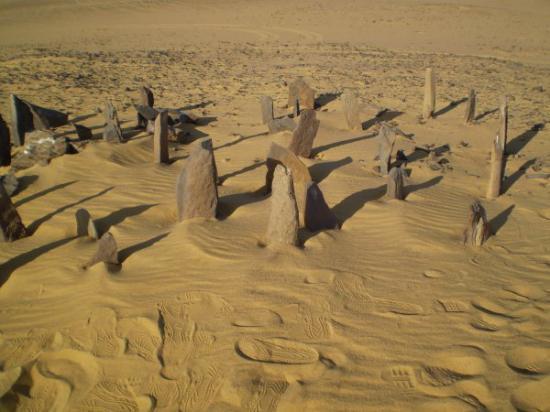One of the World's Oldest Astronomy Sites: Egypt's Nabta Playa
Source - http://www.dailygalaxy.com/my_weblog/2011/04/egypts-.html
Egypt's Nabta Playa, some 6,000 to 8,000 years old, is "one of the world's earliest known examples of archeoastronomy." Astrophysicist Thomas G. Brophy suggests the hypothesis that the southerly line of three stones inside the calendar circle represented the three stars of Orion’s Belt and the other three stones inside the calendar circle represented the shoulders and head stars of Orion as they appeared in them in the sky.

These correspondences were for two dates -- circa 4,800 BC and at precessional opposition -- representing how the sky "moves" long term. Brophy proposes that the circle was constructed and used circa the later date, and the dual date representation was a conceptual representation of the motion of the sky over a precession cycle.
Using their original measurements and measurements by satellite and GPRS measurements by Brophy and Rosen they confirmed possible alignments with Sirius, Arcturus, Alpha Centauri and the Belt of Orion. They suggest that there are three pieces of evidence suggesting astronomical observations by the herdsmen using the site, which may have functioned as a necropolis. "The repetitive orientation of megaliths, stele, human burials and cattle burials reveals a very early symbolic connection to the north." Secondly, there is the orientation of the cromlech mentioned above. The third piece of evidence is the fifth millennium alignments of stele to bright stars.[8]
They conclude their report by writing that "The symbolism embedded in the archaeological record of Nabta Playa in the Fifth Millennium BC is very basic, focused on issues of major practical importance to the nomads: cattle, water, death, earth, sun and stars.
Although at present the western Egyptian desert is totally dry, this was not the case in the past. There is good evidence that there were several humid periods in the past (when up to 500 mm of rain would fall per year) the most recent one during the last interglacial and early last glaciation periods which stretched between 130,000 and 70,000 years ago. During this time, the area was a savanna and supported numerous animals such as extinct buffalo and large giraffes, varieties of antelope and gazelle.